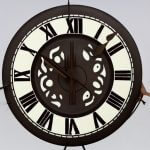8 Tips for a Productive Workspace

There are so many distractions in today’s world, how can you be expected to leave them all behind for a meaningful amount of time?
What you need is a place that forces you to think about what you need to do while cutting you off from the rest. To help, we have put together 8 tips for a more productive workspace. Let’s examine!
Productive Workspace Tip No. 1: Declutter.
A cluttered workspace is not necessarily a problem of environment. It can be a problem within the mind.
Leon Ho, founder and CEO of Lifehack, writes that the brain “has a limited amount of functions it can perform at a given time,” adding distractions and clutter “take up some of that space in the brain and reduce the space remaining for things that matter — and thinking overall.”
He is not wrong.
When you allow outside distractions to encroach on the place reserved for work, the mental energy that you have available for what you’re supposed to be working on depletes.
By decluttering your office or workspace, you start to realize where the work part fits into your life again, and that prepares you to make a dent.
No. 2: Decorate.
Decorating is different than just filling your workspace up with more crap.
When you decorate, you have the option of filling up your workspace with items that inspire you.
Posters, bookends, desk buddies — whatever you can think of that inspires the work part of your brain is welcome. Whatever doesn’t needs to go.
In other words, there is decorating to be decorating, and there is decorating for productivity.
Homedit has a list of 11 things you can do to increase the productivity. Some of our favorites include the following:
- Storing items in baskets
- Curtains to better control the amount of lighting
- Bold and vibrant colors
- Natural light
- Use of walls to “display personal items like photos, schedules, calendars, etc. and to free up your cluttered desk. You can also use them to personalize the space a little bit.”
3. Organize.
One pastime that goes well with decorating the office is organizing it. In fact, we recommend switch-tasking between the two as they will often inform one another in creating the most productive workspace.
Organizational tips, one of which we have already mentioned, include:
- Organizing in baskets or compartments
- Keeping a basket of pens handy and within reach
- Stocking and storing looseleaf paper and notebooks in one area
- Filing away any receipts that you may have to keep for tax purposes
- Clearing your desk as much as possible
The legendary Neil Patel also recommends a “catch-it space,” which is “a place to catch incoming junk.”
Patel notes “three main types of junk that flow into an office: 1) important documents, 2) stuff you need to keep (jacket, umbrella, travel mug), and 3) trash.”
Patel continued: “A catch-it space should be set up in the most obvious area of your office. If you have a door, create your catch-it space to the right of the door. If you’re in a cubicle, create a catch it space somewhere near the entrance.”
The catch-it area, he notes, should feature “a credenza or tray for documents … a shelf, hooks, or a box in which to place important items; and … a trashcan.”
4. Set the Ambience.
There are many ways that you can set the proper ambience for a productive workspace.
For starters, you will need to know how you work best — not just how you think you work best.
And don’t even try to tell us you’re more productive listening to your favorite music.
Unless that music is lyric-less classics from Bach, Beethoven, and Mozart, or something mellow and instrumental from another age of music, you’re fooling yourself.
Popular music of today gets lodged in your head with catchy beats and repetitive lyrics. It’s tough to focus on what you’re supposed to be doing when you have Bieber’s choruses pounding away.
Aside from choosing the right music (or no music), you can set ambience with the temperature of the room, background noises, etc.
The main thing is to not lose sight of the reason you’re in the workspace to begin with. It’s not to relax. It’s not to enjoy yourself. It’s to get work done.
That doesn’t mean you have to forgo a pleasant environment. To the contrary. But you should make it about the work you’re supposed to do, not feelings.
Start with the music and lighting first. These are the two items that will most make or break the workstation.
5. Leave Room to Move.
The human body was not meant to sit for prolonged periods of time. If you put yours through too much of it, health problems are not probable. They’re inevitable.
Just what kind of health problems?
Mercola Fitness lists a whole host of problems from heart and pancreas issues to colon cancer and brain damage.
Sitting for prolonged periods of time also can lead to smaller issues like bad posture, back problems, and strained neck and shoulders.
A 2015 study even found increased risks of lung cancer and uterine cancer.
If you have to sit longer than a few hours each day, make sure you break up the monotony every 60-90 minutes with on-your-feet physical activity (i.e., walking, running, elliptical, etc.).
Be careful, though.
Some people have over-corrected by moving to standing desks. As things turn out, that could be bad for you as well.
A new report from the Chicago Tribune notes that standing desks are not only bad for health, but also bad for productivity.
Going from a 12-year study of more than 7,000 office workers, the American Journal of Epidemiology found those who frequently stood at work — not walked, but stood — “were nearly twice as likely to develop heart disease as opposed to those that sat more often.”
Alan Taylor, a physiotherapy expert at Nottingham University said the “expansion [of standing desks] has been driven more by commercial reasons than scientific evidence. But the evidence is catching up and it’s showing there are some drawbacks.”
Taylor told the Tribune he believed office workers “should rely less on standing desks for their well-being and instead take more walks at work.”
6. Change It Up.
One of the biggest mistakes that a student or worker can make in choosing a productive workplace is to think it’s a static thing that will always yield the same results.
Far from it.
Like anything, things get old and tired after a while, and something needs to be done to shake things up in order to break the monotony.
That’s why we recommend not committing too heavily to one work location. It’s okay to get hung up on one for a while, but go to other locales and test them out.
It could be that you work better at a coffee shop on certain projects but do better at the library for others. Still other times, you may wish to stay in your apartment, house, or dorm room.
The key is to know what your essential tools are for working on a particular task and to have them with you at all times.
This will give you the freedom you need to keep things fresh and productive.
7. Dress the Part.
It’s hard to take your work seriously when you show up to do it in your pajamas.
That’s not to say the clothes make the work, but it does have an effect.
As Andrew Brown, group communications director at Regus, says, “What you are wearing doesn’t influence your productivity, but the state of mind that it puts you in does.”
Brown told Fast Company the important thing is “to dress in whatever you feel comfortable.”
“You will not be productive if all day you’re rearranging your clothing or breathing in to fit into those skinny jeans.”
At the same time, wearing your pajamas puts you in a waiting-to-start frame of mind, and it’s incredibly difficult to get anything done when thinking that way.
It is a fine line to walk, and what’s comfortable enough for productive work for one person is different for another.
The takeaway here is that it all ties into workstation. If you dress the part, then you’ll always look at your workspace as work-related.
If you go too casual, it will end up being like any other room, and that’s counterproductive.
8. Protect It from Outside Interference.
This may be a difficult one if you have nosy roommates or still live with family members who have boundary issues.
However, you have to take a proactive step to protect your workspace, especially when you’re using it.
Hopefully, people will understand the seriousness of your situation and give the appropriate space.
If not, have a kind but firm talk with them to explain why you require privacy.
If that doesn’t work, lock the doors, barricade yourself into the room if there are no locks, and wear ear plugs.
In Closing
Whatever you do, don’t make the mistake of thinking that you can work effectively anywhere no matter what.
We would all like to give ourselves that much credit, but the hard reality is we are poor at dealing with distractions, and our sense of self-confidence will quickly be dashed along with our productivity.
What productivity issues are you having, and what works best to keep you on task? Share your thoughts in the comments section below.
[Featured Image by Flickr Creative Commons]








